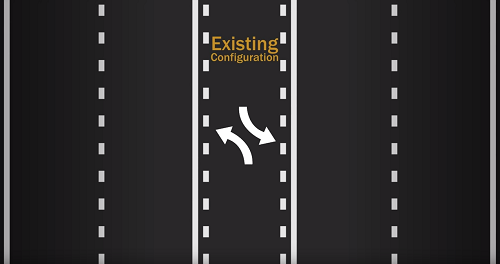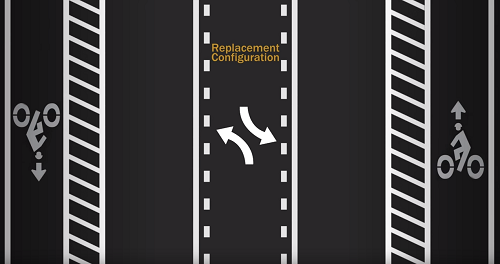Road Diets, or lane reconfigurations, are a design tool where existing roadway space is reallocated to better fit traffic conditions and expected road users. Read more about Road Diets from CityLab's So What Exactly Is a 'Road Diet'?
Road Diets in Vermont
A Road Diet will be piloted in 2016 on US Route 302, the Barre-Montpelier Road, as part of a resufacing project.
Barre-Montpelier Road Diet FAQs
Barre-Montpelier Road Diet Video
Road Diet Benefits
According to the Federal Highway Administration (FHWA), benefits of Road Diet installations may include:
- An overall crash reduction of 19 to 47 percent.
- Reduction of rear-end and left-turn crashes through the use of a dedicated left-turn lane.
- Fewer lanes for pedestrians to cross and an opportunity to install pedestrian refuge islands.
- The opportunity to install bicycle lanes when the cross-section width is reallocated.
- Reduced right-angle crashes as side street motorists must cross only three lanes of traffic instead of four.
- Traffic calming and reduced speed differential, which can decrease the number of crashes and reduce the severity of crashes if they occur.
- The opportunity to allocate the "leftover" roadway width for other purposes, such as on-street parking or transit stops.
- Encouraging a more community-focused, "Complete Streets" environment.
- Simplifying road scanning and gap selection for motorists (especially older and younger drivers) making left turns from or onto the mainline.
Every Day Counts III Initiative
FHWA has identified Road Diets as one of its Every Day Counts III (EDC) initiatives. EDC is a state-based model to identify and rapidly deploy proven but underutilized innovations to shorten the project delivery process, enhance roadway safety, reduce congestion and improve environmental sustainability. In Vermont, as well as nationally, there is an ongoing increase in people walking and biking as their means of transportation. In addition to making the road safer for motor vehicles, road diets can provide a dedicated space for people that bicycle, as well as an additional buffer from motor vehicle traffic for people on sidewalks.
Example Configuration Changes


